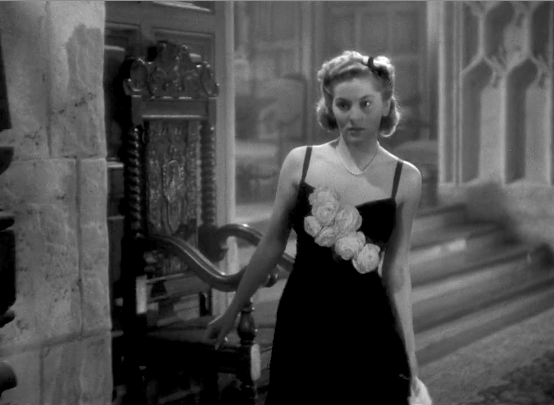Previously on Revisiting Rebecca - Nathaniel introduced us to a mousy girl with no name and no money, whose awkward charms land her Maxim de Winter. Abstew guided us through their nuptials and the introduction of Manderley, Maxim’s humble family castle. Turns out it’s filled with Maxim’s dead wife’s things, including a creepy servant named Mrs. Danvers. Just how much sway does Rebecca still hold over Manderley?
Part 3 by Anne Marie
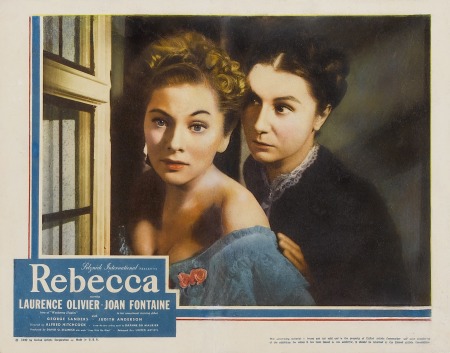
We begin where abstew left off, with #2 (aka Mrs. de Winter the Second, aka Mrs. de W2 - with about as much personality as a tax form) asking Crawley to describe Rebecca’s character. Crawley answers back with a vague, glowing physical description that makes #2 twitch and me roll my eyes. Yes, yes. Rebecca was beautiful. Maybe the moral of this movie is not to judge a woman's moral character solely by her good looks.
55:55 There’s a quick montage of a fashion magazine and crossfade to #2 dressed uncomfortably in a black dress with pearls. Eagle eyed observers may remember that this is the same outfit she promised Maxim she’d never wear. [More]
And while abstew and Nathaniel have both called her out for being wooden, I’d like to point out that Joan Fontaine was a stunning, poised young woman, who looks in this scene like a scared, gangly little girl playing dress up in a borrowed gown. It’s the awkwardness of a person unsure how to present herself because she’s unsure of herself at present. Whatever the case, Maxim responds to her new gown with the kind of patronizing, jovial tone that’s usually reserved for small children and pets. Lovely.
They sit down to watch some 8mm home movies of that honeymoon we skipped, but are interrupted when the butler informs them that Mrs. Danvers has accused a servant of stealing that statuette that #2 accidentally broke earlier. I confess that in the same situation I’d probably do as #2 did and try to bury the broken bauble, if only to avoid the cold glare of Mrs. Danvers. How can she manage to look so impassive and so judgemental at the same time?
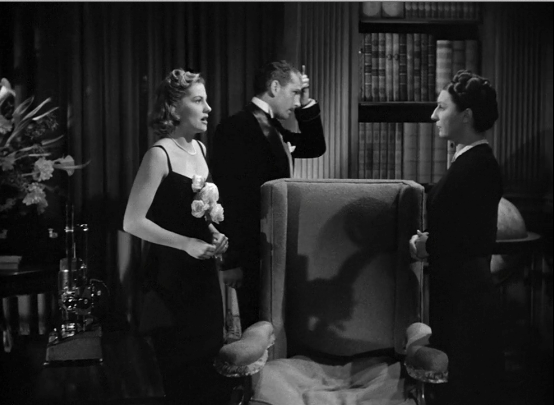 Judith Anderson is slightly shorter than Joan Fontaine. Please make note of this for later.
Judith Anderson is slightly shorter than Joan Fontaine. Please make note of this for later.
59:30 Then they’re back to watching home movies, before Maxim goes into a mood again, because Olivier never saw a moment to brood that he didn’t embrace like a dying lover on the moors. Fortunately (though I cannot believe that I am in the minority of recappers so far when I say this), Lawrence Olivier broods very, very pretty. Maxim then manages to manipulate #2 into apologizing with a line that would make E.L. James proud:
“If you say we’re happy, let’s leave it at that. Happiness is something I know nothing about.”
Cue my second eye roll in less than 10 minutes.
1:03:10 The next day, a curt letter informs #2 that Maxim has left to attend some business in the city. She cries at the window until she sees Mrs. Danvers in the supposedly closed off West Wing. #2 runs into the hall, only to hear -
A man’s voice! And not just any man’s voice. Those can only be the dry, sardonic tones of Addison deWitt George Sanders! He surprises #2 at the window, and introduces himself as Jack Flavell. Sanders then saunters out through the garden window with a tossed off remark about being “Rebecca’s favorite cousin.” (DUN DUN DUNNN!) Alas, that’s a dangling plot thread I must leave to another recapper, because it’s time for…
THE WEST WING!
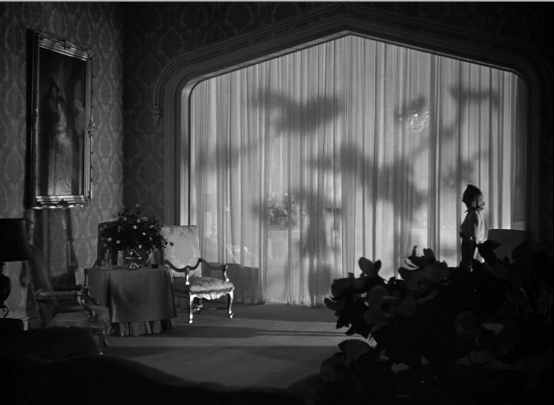 If it looks like a yonic symbol, and feels like a yonic symbol...
If it looks like a yonic symbol, and feels like a yonic symbol...
1:07:31 #2 is drawn to Rebecca’s room like a moth to a flame. This is the turning point of the film. Because behind those doors - which #2 finds unlocked - is our first glimpse at the truth of Rebecca. (Hint: it’s really, really gay.)
From a production design standpoint, Rebecca’s bedroom is sheer genius. Curtains, windows, the bed, and even Rebecca’s dressing table are all larger-than-life. They dwarf #2 with Rebecca’s presence, making the living wife look like a child sneaking into the adults’ bedroom. The other rooms of Manderly have held the stately impressiveness of old money, but Rebecca’s room is modern furnishings and a web of gauze curtains. #2 is enveloped in the presence of Rebecca de Winter. Those curtains are also good for incredible entrances.
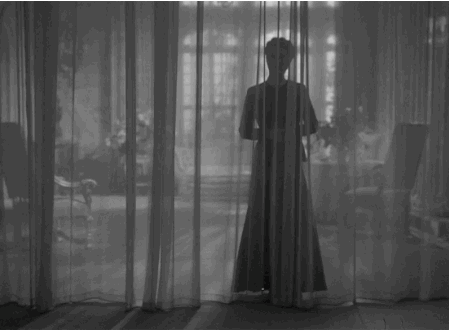
Ladies and gentlemen, Mrs. Danvers has entered the building! Mrs. Danvers is probably the most famous archetype of the evil lesbian. But if you watch the scene, you’ll be surprised by how subtle she is (compared to, say, Dame Diana Rigg fondling a nightgown, or Frau Danvers belting out a pop-opera ballad in the German musical). Here’s a smattering of her dialog:
It’s a lovely room, isn’t it? The loveliest room you’ve ever seen. Everything is kept exactly as Mrs. de Winter liked it. Nothing has been altered since that last night. Come, I’ll show you her dressing room.
Without the drama of Rebecca's room and the chilling score, this reads a little dull, doesn’t it? Pop Mrs. Danvers in a red blazer and she could be leading a real estate tour. But it’s not dialog that makes Mrs. Danvers - in fact, the Hays Office (creators of the Motion Picture Production Code and professional upholders of decency) required that Hitchcock cut his original dialog due to “quite inescapable inferences of sex perversion." So, Hitchcock relied on the oldest lesson taught to screenwriters: Show it, don't say it. This scene is all about spreading subtext through action.
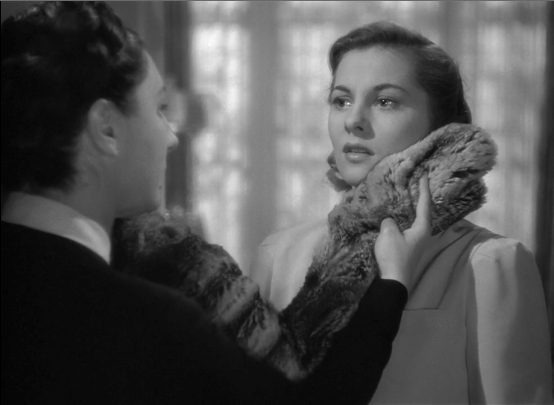
When Mrs. Danvers tells #2 to feel how soft Rebecca’s fur coat is, instead of offering it to #’2’s hand, she presses it to her cheek. When she shows off Rebecca’s finely-made clothing, it’s her underwear - woven by nuns - that’s most important. When Mrs. Danvers playacts brushing Rebecca’s hair, she manhandles #2 like a doll to take Rebecca’s place. When they finally stops at the bed, Mrs. Danvers shows #2 how delicate Rebecca’s nightgown was - so delicate as to be see-through. Judith Anderson plays the scene with an unsettling balance between absolute stillness and unresolved obsession, turning otherwise innocuous acts into something sinister.
The suggestion of sexuality hangs heavily over the scene. As with revelations still to come, the insinuation of indecency is more powerful than explicitly stating Mrs. Danvers's feelings towards her dead employer. Hitchcock was a master of suspense. He defined it as the moment before a bomb goes off. But, as there are no bombs in Rebecca (except for Third Act truth bombs, amirite?), Hitchcock instead has to build suspense on the possibility of danger. In 1940, such intense emotion as Mrs. Danvers shows for Rebecca would definitely qualify as dangerous.
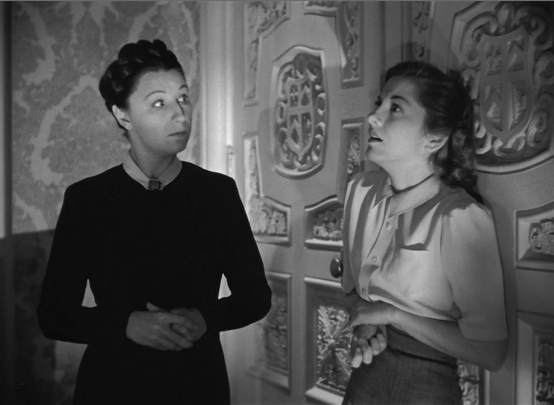 Height difference: Mrs. Danvers now towers over shrinking #2.
Height difference: Mrs. Danvers now towers over shrinking #2.
When #2 tries to escape, Mrs. Danvers corners her at the door. Mrs. Danvers remains very still, but her eyes are wild like they haven’t been before. #2 cowers before fleeing back to the “real” world of Manderley.
1:13:16 How is that confrontation the experience that gives #2 the courage to toss out Rebecca’s things? Having been in the belly of the beast, #2 screws her courage to the sticking point and orders Mrs. Danvers to clear out Rebecca’s possessions. When Mrs. Danvers protests, #2 gives her strongest line in the movie (which, incidentally, isn’t in the book):
I am Mrs. de Winter now.
Mrs. de Winter Now decides to put the queer day behind her and flies happily into Maxim’s arms when he arrives home. She asks him if they can have a costume ball, and because saying “no” to Joan Fontaine’s Hopeful Face is tantamount to kicking a hundred puppies, Maxim relents.
So we leave Mrs. de Winter Now, happily sketching dozens of ideas for the costume ball. Is Mrs. Danvers’s offer to help sincere, or does the sapphic servant have something else up her black sleeve? New TFE contributor Angelica will give us the answers… To Be Continued.
